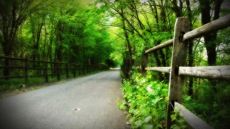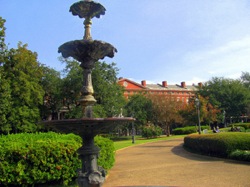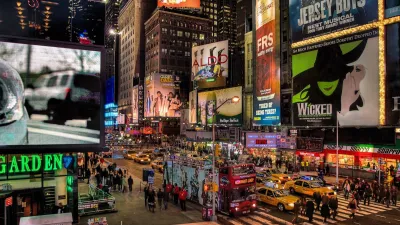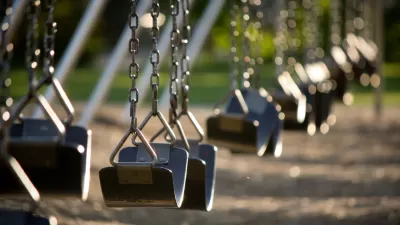A recent Planetizen interview on the relationship between park space and active living got me thinking about what spaces inspire physical activity and what spaces discourage it. In my old apartment complex, the indoor fitness centers were jammed while the nearby riverside walking trails were desolate, despite nearly perfect year-round weather. Why? The trails were perceived as unsafe because they were completely isolated from view.
A recent Planetizen interview on the relationship between park space and active living got me thinking about what spaces inspire physical activity and what spaces discourage it.
In my old apartment complex, the indoor fitness centers were jammed
while the nearby riverside walking trails were desolate, despite nearly
perfect year-round weather. Why? The trails were perceived as unsafe
because they were completely isolated from view.
 I'm somewhat perplexed by the trend in trail building: rail trails,
I'm somewhat perplexed by the trend in trail building: rail trails,
urban greenways, trails through state parks, trails through the woods
and backcountry. These may be ideal for bicyclists or for weekend
hikes with friends. But they are not practical places for solo walkers
and joggers.
Greenways, trails and ill-defined open spaces often don't work as
envisioned because planners fail to consider safety as a paramount
issue, especially for women. Even if crime statistics declare an area safe, it's really the perceived safety that counts. I am simply not
going to step onto a secluded trail (unless, perhaps, it has constant
foot traffic).
 The wilderness-like parks seem to be
The wilderness-like parks seem to be
increasingly emphasized at the expense of smaller community parks that
provide the right facilities for outdoor exercise. One element
overlooked by park planners is the community track or paved walking
loop. In the eastern US, many high school tracks are open to the
public; they tend to be safe and well-used. Out West, school tracks are
unfortunately locked and reserved for student use only. Where school
tracks are not an option, walking loops within parks are a good
alternative. These can be placed around baseball diamonds, soccer
fields, playgrounds and picnic areas.
Because park safety depends largely on visibility, walking loops should
be within the sightline of other park users as well as passersby.
Ideally, the park would offer a diversity of activities that attract
visitors. It would also be large enough for physical activity but not
so expansive that people feel lost.
I'm curious to hear from Planetizen readers about local parks that
encourage active living. What about trails and greenways? Which seem
to be heavily used for recreation and/or transportation? What makes
them work?
Photos:
1) Rail Trail in CT (adwriter/Flickr)
2) Jackson Square, New Orleans (KenSBrown/Flickr)

Maui's Vacation Rental Debate Turns Ugly
Verbal attacks, misinformation campaigns and fistfights plague a high-stakes debate to convert thousands of vacation rentals into long-term housing.

Planetizen Federal Action Tracker
A weekly monitor of how Trump’s orders and actions are impacting planners and planning in America.

San Francisco Suspends Traffic Calming Amidst Record Deaths
Citing “a challenging fiscal landscape,” the city will cease the program on the heels of 42 traffic deaths, including 24 pedestrians.

Defunct Pittsburgh Power Plant to Become Residential Tower
A decommissioned steam heat plant will be redeveloped into almost 100 affordable housing units.

Trump Prompts Restructuring of Transportation Research Board in “Unprecedented Overreach”
The TRB has eliminated more than half of its committees including those focused on climate, equity, and cities.

Amtrak Rolls Out New Orleans to Alabama “Mardi Gras” Train
The new service will operate morning and evening departures between Mobile and New Orleans.
Urban Design for Planners 1: Software Tools
This six-course series explores essential urban design concepts using open source software and equips planners with the tools they need to participate fully in the urban design process.
Planning for Universal Design
Learn the tools for implementing Universal Design in planning regulations.
Heyer Gruel & Associates PA
JM Goldson LLC
Custer County Colorado
City of Camden Redevelopment Agency
City of Astoria
Transportation Research & Education Center (TREC) at Portland State University
Jefferson Parish Government
Camden Redevelopment Agency
City of Claremont




























